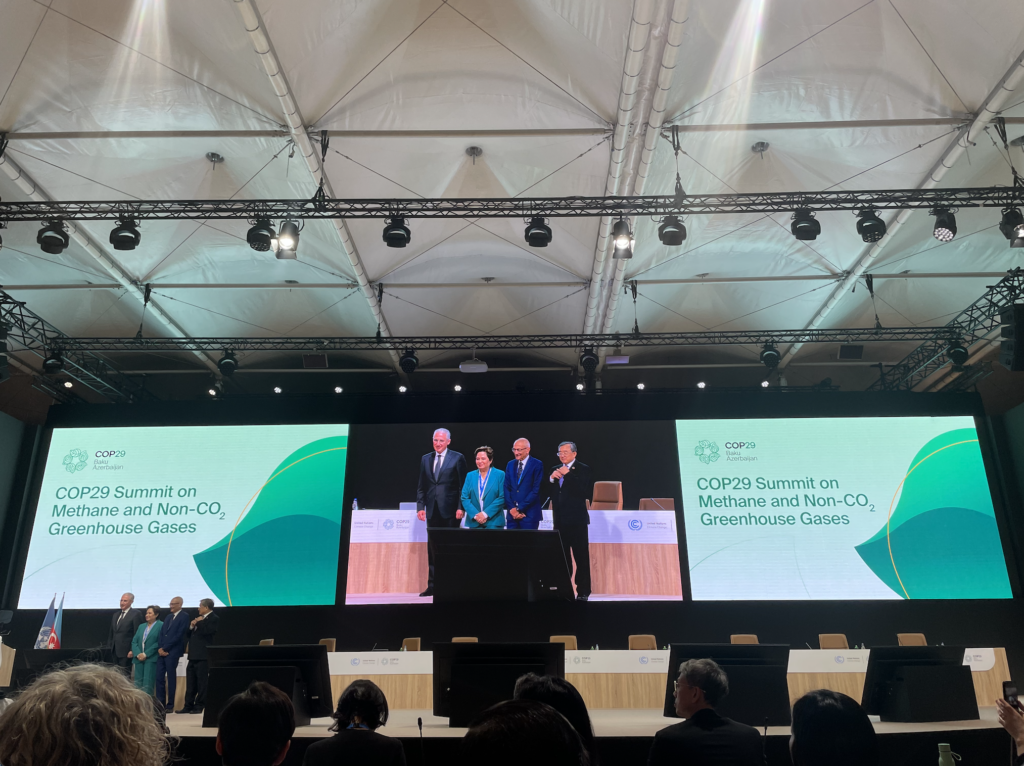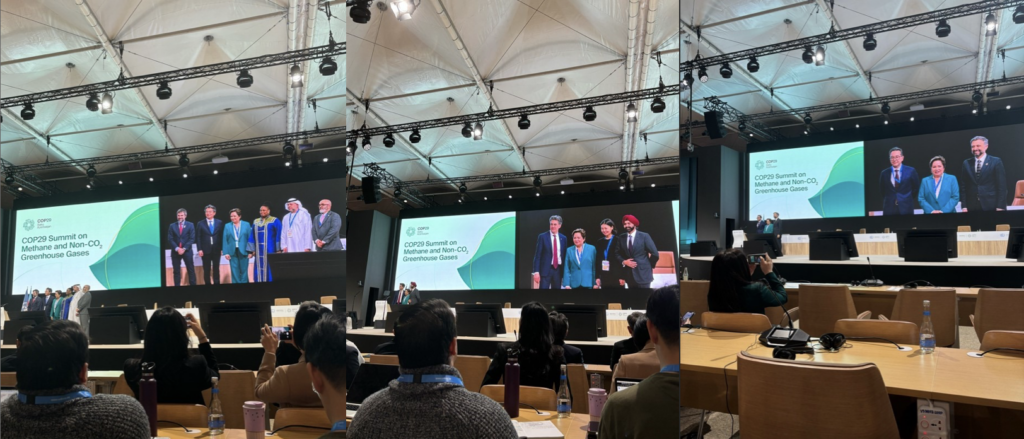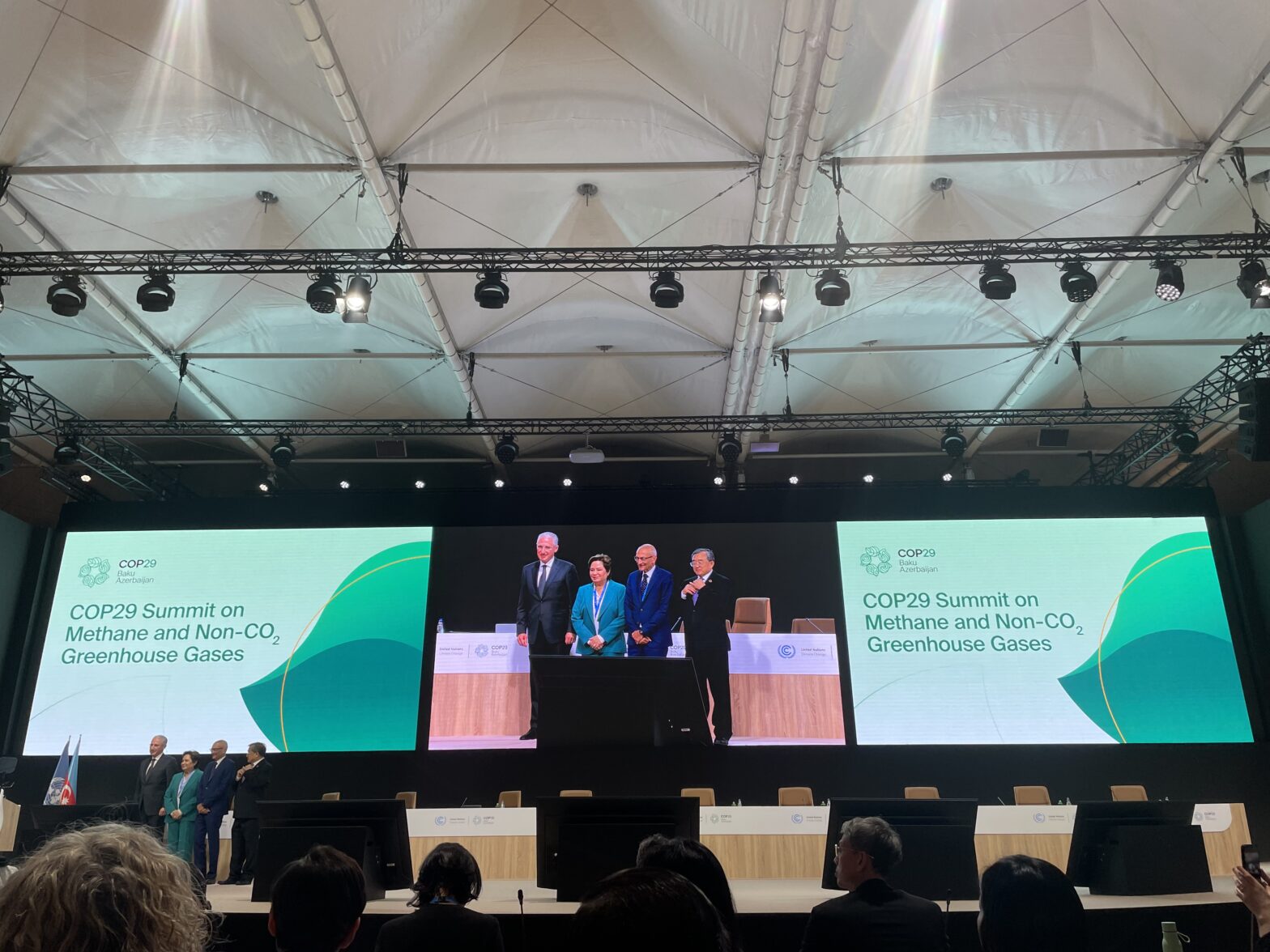By Megan O’Brien, ’25, Environmental Studies and Havalin Haskell, ’26, Environmental Studies

When we caught wind of the possibility of garnering tickets to attend the High-Level Summit on Methane and Non-CO2 Greenhouse Gases (GHGs), we immediately busted a move to the Delegation Pavilions, navigating the maze to find the Methane Pavilion. This Summit caught our attention for many reasons and was one of the main focuses of Day 2 at COP29 in the Blue Zone, not only because of the importance of the arguably often overlooked topic of non-CO2 GHGs, but also because it was co-hosted by a rather unique collaboration between the United States, the People’s Republic of China and Azerbaijan. The co-host pairing makes sense, though, when it comes to China and the United States being two of the highest emitters and largest economies—as was pointed out by John Podesta in his remarks, the United States accounts for around 10% of global greenhouse emissions and China 30%.
Walking into the large Plenary Hall where the Summit was hosted, a sense of grandiosity and importance flooded over us—just university students among climate change giants. We were told we could sit anywhere, so naturally, we chose two rows from the front panel, in the very center of it all. Who sits down a row in front of us? John Podesta himself, United States Senior Advisor to the President for International Climate Policy and China’s Special Envoy for Climate Change, Liu Zhenmin.
Behind us was the delegation of Nigeria, headed at this summit by Dr. Nkiruka Maduekwe, the Director General of the National Council of Climate Change in Nigeria. We observed a woman with a powerful presence coming directly up to speak with them, warmly expressing her excitement at seeing them like old friends. I caught a glimpse of her badge, and of course looked her up: Sadie Tucker, Macroeconomics and Crypto-economics Officer of the US State Department. Now that is the essence of being a student at COP—being surrounded by high level policymaking celebrities; in constant awe of their outfits, their powerful presence, the sheer immensity of intelligence and passion in the air, yet seeing them also interact interpersonally, remembering their humanity, their personhood.
This summit itself arguably epitomized the stereotypical “essence” of the United Nations; thick with diplomatic nicety and international idea sharing. It has been interesting to observe when geopolitical tensions are overcome for the sake of climate collaboration and when tensions have bled into COP29 spaces. We would argue that this space was one where geopolitical baggage was often left at the door; however, countries receiving support and collaboration did so with either the US or China, while none mentioned both.
Super pollutants, non-CO2 greenhouse gasses like methane, nitrous oxide, and hydrofluorocarbons (HFCs) haven’t been in the center of public attention or climate change dialogue quite like carbon dioxide. However, these non-CO2 gasses have been labeled super pollutants for a reason—they are responsible for approximately half of near-term global warming, as they are dozens, hundreds, or even thousands of times more potent than carbon dioxide. Methane, for example, has 80 times the warming power of CO2. Tackling these potent gasses is the fastest and often cheapest way to slow temperature rise and avoid the most severe climate impacts, a crucial aspect alongside critical efforts to cut carbon dioxide emissions.

As the Commissioner for Climate Action for the EU, Wopke Hoekstra, stated: cutting “CO2 is the marathon, methane is the sprint.” In other words, if the world is to cut emissions by 42% by 2030 to limit global warming under 1.5 degrees Celsius, non-CO2 GHGs need to be a major focus of international efforts, and according to John Podesta, “global consensus is stronger than ever” regarding this notion. This urgency was present across the Summit—as Hoekstra, strongly stated: “We have six years left to turn our commitments into action,” and most leaders who spoke emphasized the progress made, being dampened by a major “but”efforts are not enough, and not fast enough. Podesta ended his statement by appealing to a rhetoric of duty: “For our sake, for our children’s sake, failure is not an option.”
The speakers present at this summit were a somewhat star-studded cast set against the backdrop of a world that is hurtling towards 2024 being the warmest year on record. The first round of speakers was started by John Podesta (US), Mukhtar Babayev (Azerbaijan), and Liu Zhenmin (China). As mentioned above, John Podesta, kicked things off setting the scene for future speakers, offering a here’s the context, “here’s what we’ve done, and here’s what is still to be done” framework.
The US and China have the two largest economies in the world and are the biggest emitters, as mentioned above. Together, the US and China account for 30% of global Coal Seam Gas (CSG) emissions. This type of methane is found within coal deposits and is a major source of emission. Across the board, speakers at this summit acknowledged methane and non-CO2 emissions as the fastest and cheapest way to slow warming. Steven Guilbert, the Minister of the Environment from Canada, even went as far to state that if the global goal of emission reduction is reached by 2030 it would have the same effect as stopping all of the world’s cars, ships, and airplanes. Considering, in the US alone, transportation makes up 28% of greenhouse gas emission, the impact would be massive. Podesta then went on to identify the sources of methane to consider, the energy sector, agriculture, and waste.
The presidency at COP29 has announced a focus on the waste sector this year and Edward Miliband, the Secretary of State for Energy Security and Net Zero of the United Kingdom, reminded us that agriculture will be the focus of COP30. The efforts in this next year will be focused towards waste, however that begs the question of how much focus will be taken away from oil and gas, where the Vice President of SOCAR (the State Oil Company of the Azerbaijan Republic) acknowledged that they will not reach their Net-Zero goal by 2030. Afghan Isayev stated a hope for SOCAR that by “2050 we will reach net-zero” which holds continuity with other countries and organizations pushing for an extension on the 2030 goal. Not all results and reports were as bleak as SOCAR’s. Many countries were able to tout very big accomplishments, the US being one of them. Some of these include the Waste Emissions Charge to incentivize reduction of harmful methane pollution, an updated National Methane Reduction Action Plan with $18 billion in funding disbursed in 2024, and a reinforced intention to update emissions standards before 2025 when the presidency turns over.
Other countries showcased their success as well. One of the World Banks’ 40 initiatives included incentivizing farms to use better feed and manure disposal. Furthermore, one wouldn’t necessarily expect it, but rice is a large source of methane emissions. This can be addressed through better irrigation systems, and you guessed it, funding! The US has identified a new feed additive that can reduce emissions from livestock by as much as 30%. Both the EU and the UK shared their plans to support other countries in their efforts through funding. The EU also outlined their MAPR plan which is a global step by step rubric to reduce methane. They did this with the collaboration of the US and Japan. Kazakhstan joined the Global Methane Pledge, alone with Brazil, and reduced the amount of gas flared by more than 70%. Canada, the 4th largest oil and gas producer, announced plans for 2025 and shared their launched methane initiative in Chile that has since been expanded to 23 other countries.
Liu Zhenmin, approached the Summit with something arguably rare in these spaces; humble honesty about China’s weaker actions towards reducing non- GHG emissions. He admitted China has been “relatively late to controlling methane gas specifically, and that the country overall lacks “effectives standardized protocols,” and funding allocation towards the efforts. Yet, he also emphasized that since the release of the Methane Emissions Control Action Plan, China has engaged in building fundamental capacities and enhancing policy frameworks towards their goal of lowering the emission limit from the current 30 percent to 8 percent in the latest version of the Emissions Standards of Coal-bed Methane. He ended with quite a powerful remark that reverberated across the grand Plenary Hall: “I hope US and China collaboration on global climate change will continue.”
Lowering emissions of non-CO2 GHGs is a source of hope for a couple reasons. First, it not only will work to slow the global lower warming trajectory in a major way, but it’s feasible and economical, which makes it appealing for nations and the private sector alike, including the main perpetrators of the issue, oil and gas companies. As the Minister of Environment of Canada, Steven Guilbert, argued in regard to non-CO2 GHG regulations: “You know you have succeeded when those who fought you tooth, and nail are now claiming credits for the efficiency.”
This phenomenon was on full display at this Summit, within Afghan Isayev, the Vice President of SOCAR’s long-winded monologue. SOCAR, Azerbaijan’s National Oil and Gas company is a major sponsor of the COP, one of 3 methane emitters in the oil and gas sector in Azerbaijan, and a firsthand example of the increased presence and influence of fossil fuel lobbyists within these climate summits over the past three years where the host countries have been petrostates. And indeed, Isayev was a presence. He spoke for longer than anyone else in the Summit and broke the news that SOCAR would not meet the goal of emission reductions by 2030 in a rather joking manner, we think in an attempt to minimize the impact of that reality. He continued his “off the cuff” speech by emphasizing the pressure oil and gas companies are receiving, explaining how the intense criticism “continuously kicking the tails” of SOCAR, causing them to “accept,” “say sorry,” and “collaborate.” He especially elaborated on accepting the data from cutting-edge methane-detecting satellites because it’s expensive data “provided for free” to identify leaks that work to improve the efficiency of their plants. Isayev sent a message to other oil and gas companies, saying “they are coming for you, there is no escape anymore.”

We left the summit with a stronger understanding of the specifics around methane and non-CO2 gas emissions, but also greater international dynamics regarding regulations and funding. Speakers took a variety of approaches to sharing their goals and results, but undoubtedly those who spoke clearly and concisely, like Ajax Banga, President of the World Bank, had the most resounding impact. It was very apparent in his remarks that there was no “should” or vaguely instructive language, just what the World Banks has done and what they will do. This could perhaps be a lesson in many other parts of the COP environment, where time is of the essence on multiple levels- it only being a two-week conference, but that we only have six more years to achieve emission reduction goals to mitigate a planetary tipping point of warming. In the context of methane and non-CO2 gasses, Wopke Hoekstra, put it best “These are all low hanging fruits, and they become even lower when we all work together.” Such an international problem truly requires an efficient and collective response.
